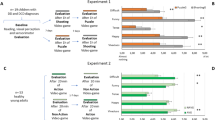Abstract
The purpose of this study was to evaluate the role of overt and covert self-rule statements on the execution of a chained task by participants with developmental disabilities. A multiple baseline design across participants with multi-element phases embedded was used to evaluate the effects of overt and covert self-rules, alternating with blocking and nonblocking phases, on skill acquisition, generalization, and maintenance, in the absence of explicit reinforcement contingencies for accurate performance. All three participants demonstrated acquisition of the chained task and generalization to novel stimuli. Performance was shown to be only moderately disrupted for some participants during conditions in which the emission of overt and covert self-rules were blocked, raising questions regarding the degree to which a functional relationship between task completion and self-rule statements was obtained. Results are discussed in terms of the practical utility of teaching individuals to respond as listeners to their own emission of overt and covert self-rules as speakers.

Similar content being viewed by others
References
Anderson, C. M., Hawkins, R. P., Freeman, K. A., & Scotti, J. R. (2000). Private events: do they belong in a science of human behavior? The Behavior Analyst, 23, 1–10.
Catania, A. C., Shimoff, E., & Matthews, B. A. (1989). An experimental analysis of rule-governed behavior. In S. C. Hayes (Ed.), Rule-governed behavior: cognition, contingencies, and instructional control (pp. 119–150). New York: Springer US.
Cooper, J. O., Heron, T. E., & Heward, W. L. (2007). Applied behavior analysis. Upper Saddle River: Pearson Education, Inc..
de Souza, A. A., & Rehfeldt, R. A. (2013). Effects of dictation-taking and match-to-sample training on listing and spelling responses in adults with intellectual disabilities. Journal of Applied Behavior Analysis, 46, 792–804. doi:10.1002/jaba.75.
Ericsson, A. K., & Simon, H. A. (1984). Protocol analysis: verbal reports as data. Cambridge: MIT Press.
Faloon, B. J., & Rehfeldt, R. A. (2008). The role of overt and covert self-rules in establishing a daily living skill in adults with mild developmental disabilities. Journal of Applied Behavior Analysis, 41, 393–404. doi:10.1901/jaba.2008.41-393.
Hayes, S. C. (1986). The case of the silent dog-verbal reports and the analysis of rules: a review of Ericsson and Simon’s protocol analysis: verbal reports as data. Journal of the Experimental Analysis of Behavior, 45, 351–363. doi:10.1901/jeab.1986.45-351.
Matthews, B. A., Shimoff, E., & Catania, A. C. (1987). Saying and doing: a contingency-space analysis. Journal of Applied Behavior Analysis, 20, 69–74. doi:10.1901/jaba.1987.20-69.
Skinner, B. F. (1957). Verbal behavior. New York: Appleton-Century-Crofts.
Taylor, I., & O'Reilly, M. F. (1997). Toward a functional analysis of private verbal self- regulation. Journal of Applied Behavior Analysis, 30, 43–58. doi:10.1901/jaba.1997.30-43.
Author information
Authors and Affiliations
Corresponding author
Ethics declarations
Ethical Approval
All procedures performed in studies involving human participants were in accordance with the ethical standards of the institutional and/or national research committee and with the 1964 Helsinki declaration and its later amendments or comparable ethical standards.
Informed Consent
Informed consent was obtained from all individual participants included in the study.
Conflict of Interest
None of the authors report any conflicts of interest.
Appendix 1
Appendix 1
Task Analysis
-
1.
Take the kale from the fridge, and bring it to the table.
-
2.
Put 1/4 of a cup of kale into the measuring cup.
-
3.
Put 1/4 of a cup of kale into the mixing cup.
-
4.
Put the kale back into the fridge.
-
5.
Take the fruit from the fridge, and bring it to the table.
-
6.
Put 1/4 of a cup of fruit into the measuring cup.
-
7.
Put 1/4 of a cup of fruit in the mixing cup.
-
8.
Put the fruit back into the fridge.
-
9.
Take the milk from the fridge, and bring it to the table.
-
10.
Pour 1 cup of milk into the measuring cup.
-
11.
Pour 1 cup of milk into the mixing cup.
-
12.
Screw the blade onto the mixing cup.
-
13.
Place the blade end of mixing cup into the blender.
-
14.
Place your hand on top of the blender, and turn the mixing cup until it starts.
-
15.
Let the smoothie mixture blend until it is smooth.
-
16.
When smooth, turn the cup until you hear a click to stop it from blending.
-
17.
Remove the mixing cup from the blender.
-
18.
Shake the smoothie mixture to incorporate all the ingredients.
-
19.
Place the mixing cup on the table.
-
20.
Unscrew the blade from the mixing cup.
-
21.
Pour smoothie into personal cup.
Rights and permissions
About this article
Cite this article
Root, W.B., Rehfeldt, R.A. & Castro, M. Some Refinements of a Methodology for Examining the Influence of Overt and Covert Self-Rules on Task Completion. J Dev Phys Disabil 29, 475–488 (2017). https://doi.org/10.1007/s10882-017-9538-0
Published:
Issue Date:
DOI: https://doi.org/10.1007/s10882-017-9538-0




